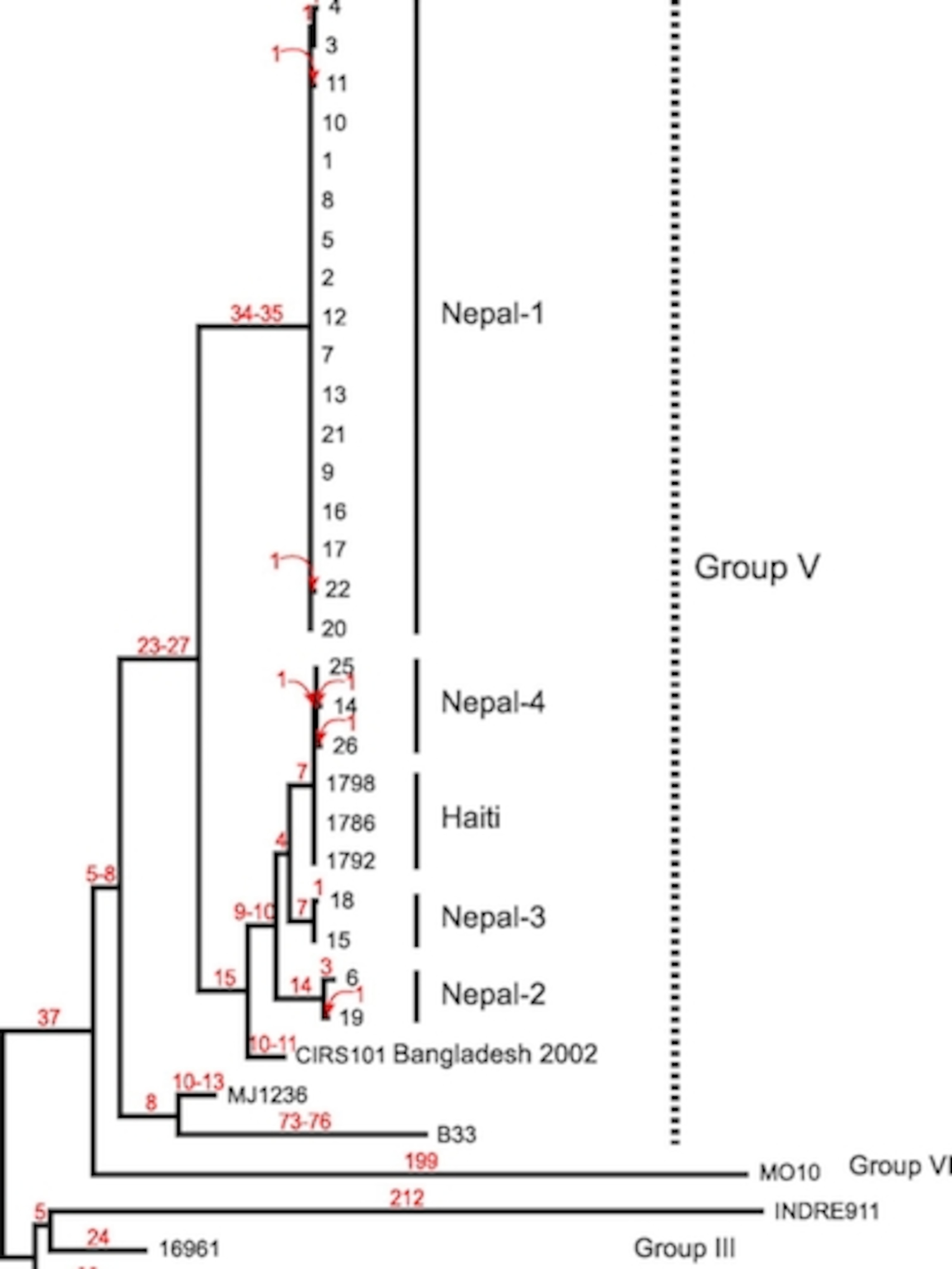In the wake of last year’s earthquake in Haiti, cholera arrived on the island for the first time in 60 years. According to the World Health Organization, 419, 511 Haitians got sick with cholera as of July 31, of which 5,968 died. The infection rate is dropping right now, but the arrival of Hurricane Irene could change that.
As I wrote in December, scientists applied evolutionary biology to find clues to how cholera–or, more precisely, the bacteria Vibrio cholerae— came to Haiti. They compared the DNA in the strain in Haiti to ones that have been found in other parts of the world. From this analysis, they drew a tree, which I’ve reprinted below.

The bacteria in Haiti was more closely related to strains in South Asia than ones from South America. So it was unlikely that cholera came to Haiti floating by water from a nearby country. The evolutionary tree led credence to idea that U.N. peacekeeping troops, some of whom came from Nepal, brought it with them by plane. An outbreak of cholera hit Nepal in September 2010, shortly before a battalion of Nepalese peacekeepers left for Haiti.
This analysis was a bit like a picture taken from 10,000 feet in the air. The bacteria that the scientists analyzed were just a small selection of the many strains that have made people sick over the past few decades. Notably missing from the tree were any bacteria from Nepal. That’s because those strains had not made their way into bacteria collections.

To get a picture up close–and to test the idea that U.N. peacekeepers brought cholera to Haiti–a team of Nepali, American, and Danish researchers collected 24 samples in Nepal at the end of last year. They sequenced the entire genomes of bacteria and compared them to the genomes of Haitian cholera. They reported their results today in the journal mBio.
And here’s their close-up tree. It clearly shows that the Haitian cholera strain evolved from one of four related lineages of V. cholerae circulating today in Nepal. It differs from the Nepalese strain by a single mutation.
It’s amazing that genome-sequencing methods have gotten so powerful that scientists can now use entire genomes to reconstruct an intercontinental outbreak. Yet ten months passed from the outbreak to the publication of this paper. In a blog at the mBio site, co-author Paul Keim explains why: politics. Governments can be reluctant to give up samples that might make them look bad. Building an evolutionary tree of a deadly outbreak takes more than data: it can take a lot of diplomacy, too.
Update: Martin Enserink, writing in Sciencewriting in Science, raises the question of whether the United Nations should compensate Haiti for the outbreak that this study now clearly lays at their doorstep. Hoo boy!
Go Further
Animals
- Octopuses have a lot of secrets. Can you guess 8 of them?
- Animals
- Feature
Octopuses have a lot of secrets. Can you guess 8 of them? - This biologist and her rescue dog help protect bears in the AndesThis biologist and her rescue dog help protect bears in the Andes
- An octopus invited this writer into her tank—and her secret worldAn octopus invited this writer into her tank—and her secret world
- Peace-loving bonobos are more aggressive than we thoughtPeace-loving bonobos are more aggressive than we thought
Environment
- This ancient society tried to stop El Niño—with child sacrificeThis ancient society tried to stop El Niño—with child sacrifice
- U.S. plans to clean its drinking water. What does that mean?U.S. plans to clean its drinking water. What does that mean?
- Food systems: supporting the triangle of food security, Video Story
- Paid Content
Food systems: supporting the triangle of food security - Will we ever solve the mystery of the Mima mounds?Will we ever solve the mystery of the Mima mounds?
- Are synthetic diamonds really better for the planet?Are synthetic diamonds really better for the planet?
- This year's cherry blossom peak bloom was a warning signThis year's cherry blossom peak bloom was a warning sign
History & Culture
- Strange clues in a Maya temple reveal a fiery political dramaStrange clues in a Maya temple reveal a fiery political drama
- How technology is revealing secrets in these ancient scrollsHow technology is revealing secrets in these ancient scrolls
- Pilgrimages aren’t just spiritual anymore. They’re a workout.Pilgrimages aren’t just spiritual anymore. They’re a workout.
- This ancient society tried to stop El Niño—with child sacrificeThis ancient society tried to stop El Niño—with child sacrifice
- This ancient cure was just revived in a lab. Does it work?This ancient cure was just revived in a lab. Does it work?
- See how ancient Indigenous artists left their markSee how ancient Indigenous artists left their mark
Science
- Jupiter’s volcanic moon Io has been erupting for billions of yearsJupiter’s volcanic moon Io has been erupting for billions of years
- This 80-foot-long sea monster was the killer whale of its timeThis 80-foot-long sea monster was the killer whale of its time
- Every 80 years, this star appears in the sky—and it’s almost timeEvery 80 years, this star appears in the sky—and it’s almost time
- How do you create your own ‘Blue Zone’? Here are 6 tipsHow do you create your own ‘Blue Zone’? Here are 6 tips
- Why outdoor adventure is important for women as they ageWhy outdoor adventure is important for women as they age
Travel
- This royal city lies in the shadow of Kuala LumpurThis royal city lies in the shadow of Kuala Lumpur
- This author tells the story of crypto-trading Mongolian nomadsThis author tells the story of crypto-trading Mongolian nomads
- Slow-roasted meats and fluffy dumplings in the Czech capitalSlow-roasted meats and fluffy dumplings in the Czech capital